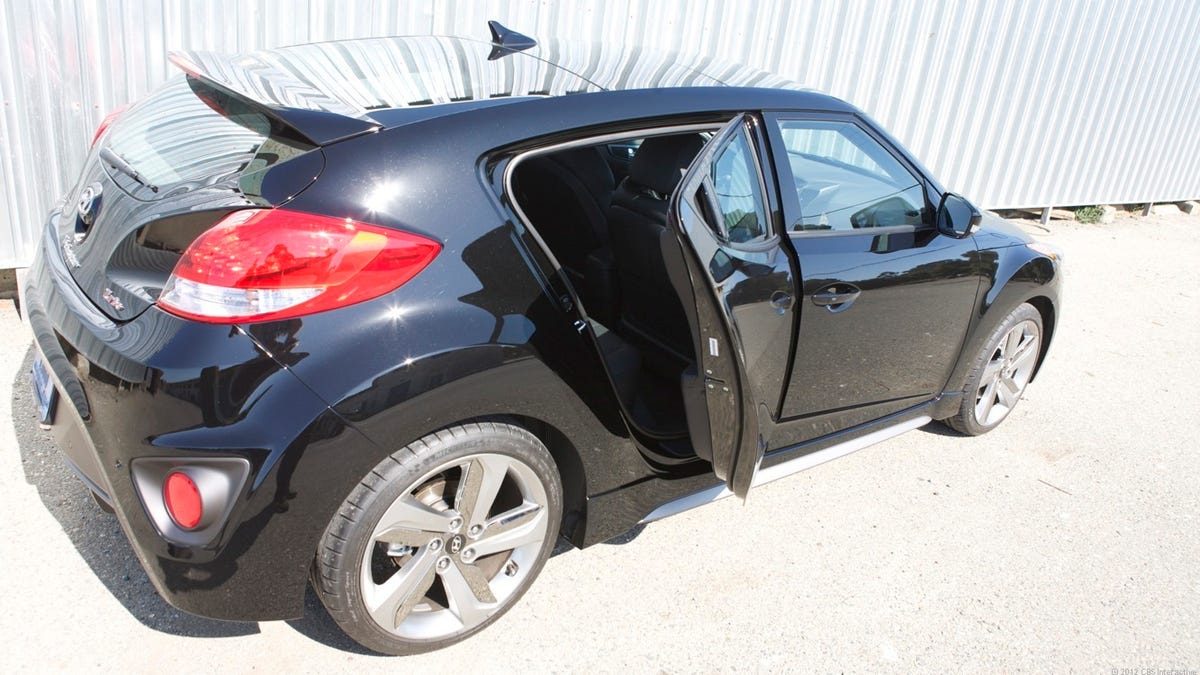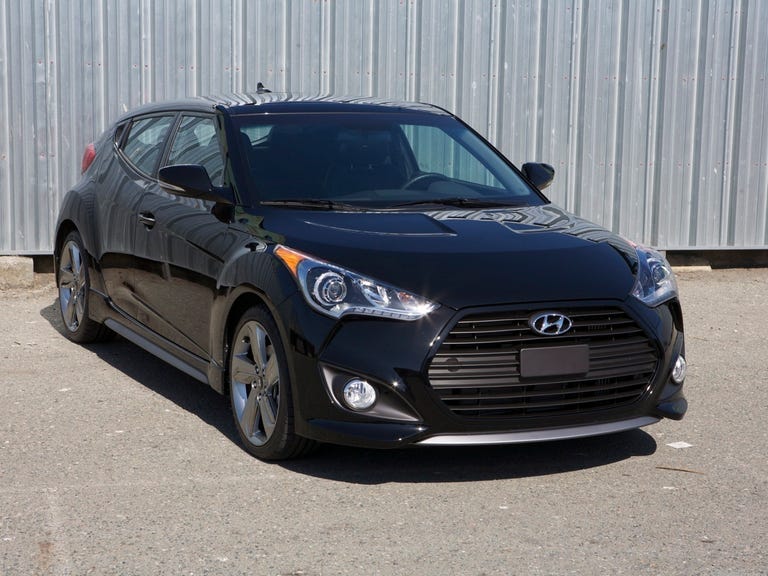 Why You Can Trust CNET
Why You Can Trust CNET 2013 Hyundai Veloster Turbo review review: Hyundai boosts the Veloster's performance
The 2013 Hyundai Veloster Turbo adds a helping of performance substance to go with its asymmetrical style.
The 2013 Hyundai Veloster Turbo's biggest gimmick -- aside from the eponymous turbo, which we'll get back to shortly -- is its asymmetrical design. Viewed from the driver's side, the Veloster appears to be a three-door hatchback. However, viewed from the passenger side, it looks like a five-door. The truth is somewhere in between: Hyundai's Veloster is an unconventional four-door hatchback with one door on the driver's side, two doors on the passenger's side, and the lifting hatch out back.
The Good
The Bad
The Bottom Line
The doors
Aside from just looking weird and being a conversation piece, there are advantages to this uneven configuration. Firstly, the second, smaller door on the passenger side allows for easier access to the rear seat without having to tilt the front seat forward. Two doors are shorter than one long door and swing out a shorter distance from the side of the vehicle, so a Veloster driver cramming into a tiny parking space can get closer to a wall or other obstruction on the passenger side without inhibiting the swing of the doors. (By comparison, the driver's side door is almost ridiculously long.)
The Veloster's hatchback form factor with fold-flat rear seats also allows city dwellers to cram a lot of cargo room and stuff-carrying capacity into a relatively small parking space, which is a treat for city living. During my week with the Veloster, I purchased two road bikes and was able to fit the boxes of both of them into the cavernous rear hatch with plenty of room to spare.

The Veloster's extra passenger-side door is barely visible when shut, but makes the rear seat much more accessible.
But that's all form and function stuff, what about the design?
Well, the Veloster uses Hyundai's Fluidic Sculpture design language, which -- as seen in the Sonata, for example -- usually manifests itself in organic curves and flowing, windswept looks. The Veloster Turbo, however, is a good deal more aggressive.
Massive swept-back bug-eyed headlamps flow from the front end of the vehicle and up the fenders. They are joined to the housings of the circular fog lamps by deep creases that echo the hexagonal blacked-out grille that is both larger and more sinister-looking than the non-turbo Veloster's. On our Ultra Black test car, the scale of the grille is visually minimized, but on more brightly colored models, it looks downright massive.
The rear end is characterized by a huge center exhaust with dual round tips that are surrounded by a matte black plastic "diffuser" that generates more second glances than downforce and the same high rump and beetlelike taillamps as the non-turbo model. There's also the same gun-slit rear glass that offers very poor rearward visibility and makes a compelling case for the optional rearview camera.
You can discern the Turbo models by their enlarged, central exhaust with dual round tips.
The turbo
Beneath the Veloster Turbo's sculpted hood spins a 1.6-liter, four-cylinder engine that is augmented with a twin-scroll turbo and gasoline direct-injection technology. This is, as I understand, the same 1.6-liter block that every Veloster is powered by, only with the addition of the turbocharger and upgrades to handle the increased air intake pressure.
Output is rated at 201 horsepower and 195 pound-feet of torque, up 63 ponies over the model that we tested last year and 72 pound-feet of torque. Almost all of that power lives in the upper ranges of the tachometer; thankfully the "twin-scroll" tech in the turbo helps to minimize lag (but not totally eliminate it), so you're not stuck waiting for the torque to pile on. We called the last Veloster to pass through the Car Tech garage out on its inability to back up its aggressive looks with performance. On paper, at least, that's no longer the case.
The small engine makes use of a twin-scroll turbo to make big power.
The engine is paired with a standard six-speed manual transmission that features gear ratios that are unique to the Turbo model. The shifter has nothing on the stick you'll find in a Honda Fit or Mini Cooper, but it feels nice enough in the hand and its gates are reasonably well-defined with one very heinous exception.
The Veloster's manual shifter is equipped with what's called a first-gear lockout mechanism, the purpose of which is to prevent careless drivers from shifting into first gear when they mean to go to third and potentially damaging the transmission. In theory, this is a good thing. In practice, the Veloster's first-gear lockout is a nightmare in itself, occasionally getting stuck shut or half shut and preventing me when it was time to get moving again from shifting into first gear without much jiggling and mangling of the shift lever -- that's if you haven't stalled because you've ended up in third gear. This made our Veloster Turbo tester almost maddeningly difficult to enjoy on the streets of San Francisco, where stops are frequent and often on an incline.
A quick dive into a few Veloster enthusiast forums revealed that, while this is a known issue, not every Veloster Turbo driver has experienced it. However, I feel this issue is something that potential owners should be aware of and beware of.
I normally enjoy manual transmissions, but the Veloster Turbo's shifter was a huge pain.
On the bright side, once you get the turbo spinning and the gears engaged the Veloster is a joy to drive, delivering great power from its 1.6-liter engine and delivering up to 26 mpg in the city, 38 on the highway, and 30 combined mpg according to the EPA's estimates. My testing yielded a trip computer recorded 26.9 mpg at the end of the week, which included a day of back-road carving, a good deal of highway cruising, and just a bit of cursing at first gear during city driving.
A six-speed automatic transmission with paddle shifters is available on the Veloster Turbo for those who don't know what to do with a clutch pedal, but this unit is not the same dual-clutch model that is available on the non-Turbo Veloster.
The tech
The cabin technology available in the Veloster Turbo is identical to what you get in the non-Turbo Veloster trim levels, only with more features listed as standard.
For starters, the 450-watt Dimension premium audio system is standard, so every Veloster that wears the Turbo badge is packing eight speakers including a subwoofer and an external amplifier. Audio quality is pretty darn good for a vehicle in the Veloster's price range, offering very full bass with no rattling from body panels or noticeable harshness of the sound. Digital signal processing (DSP) software creates virtual surround sound that expands two-channel audio inputs, and automatic volume control boosts the output as vehicle speed (and road noise) increases.
Every Veloster Turbo should come with a USB key preloaded with Korean pop star PSY's song "Gangnam Style"!
The Veloster Turbo's dashboard is always home to a 7-inch color touch screen, even if you don't spec the optional turn-by-turn navigation software. If you do get nav, you'll also get a 90-day trial of SiriusXM NavTraffic which is reasonably good if your commute tends to stick to major highways and arteries, but had a bad habit of leading me directly into surface-road traffic jams in San Francisco. (To be fair, my testing occurred on what many would consider to be one of the worst weekends for traffic this year.)
The navigation system's maps now feature a three-quarter view in addition to the top-down 2D view that most Hyundai systems have been restricted to. I also like that the destination input menus don't lock the driver out while the vehicle is in motion -- although I'm sure many anti-distraction advocates will scream bloody murder.
Audio sources that feed into the system include a single-slot CD player, AM/FM terrestrial radio, USB and iPod connectivity, Bluetooth audio streaming and hands-free calling, SiriusXM Satellite Radio, a 3.5mm analog auxiliary input, and an RCA analog audio and video input. As part of an optional package, our Veloster also featured a 115-volt AC power outlet in the center console, which allowed me to plug in my Xbox 360 video game consoles to play games on the 7-inch display when parked. Sweet.
The Hyundai's navigation software finally gets upgraded with 3D maps.
Like many Hyundai models that have come before it, the Veloster features an excellent, if not simple, voice command system that can handle destinations and addresses for navigation input and contact dialing for hands-free calling.
The non-Turbo Veloster was the first Hyundai model to offer the automaker's Blue Link telematics system as a standard feature, so it's no surprise to see the system here on the Turbo. You can read all about it in the full review of the 2012 Hyundai Veloster.
The price
As tested, our 2013 Hyundai Veloster Turbo stickered at $26,520. That included the $21,950 base price for the turbocharged model, $95 for carpeted floor mats, $1,200 for 215-width Michelin Pilot Super Sport summer tires to wrap around the standard 18-inch wheels, and $2,500 for the Ultimate Package.
The Ultimate Package includes a Panoramic sunroof that essentially occupies the entire roof of the vehicle, audible rear proximity sensors, the navigation system with rearview camera, automatic headlights, and the 115V A/C outlet.
The $26,520 that Hyundai is asking is just a bit pricey, in my opinion. It's not that the Veloster Turbo isn't a good car on its own, but it faces some stiff competition. You could buy a fully loaded Honda Civic Si and have money left over for modifications, a reasonably well-equipped Scion FR-S, or even a Hyundai Genesis Coupe 2.0T R-Spec for that price and that's just the tip of the iceberg. If I'm looking to go as fast as possible for about $27K, there are so many better options. To be fair, the Veloster out-geeks nearly every car on that list with its higher level of cabin tech, offers more flexibility with its proper hatchback, and out-weirds all of them with its asymmetrical design. The quirky hatchback has character and that, for some drivers, may be more important than performance bragging rights.
| Tech specs | |
| Model | 2013 Hyundai Veloster |
| Trim | Turbo |
| Power train | 1.6-liter GDI with twin-scroll turbocharger, 6-speed manual transmission, FWD |
| EPA fuel economy | 26 mpg city, 38 mpg highway, 30 combined mpg |
| Observed fuel economy | 26.7 mpg |
| Navigation | Optional with SiriusXM NavTraffic |
| Bluetooth phone support | Standard with voice command |
| Disc player | Single-slot CD |
| MP3 player support | Standard analog 3.5mm auxiliary input, USB connection, Bluetooth audio streaming, iPod connection, RCA audio/video input |
| Other digital audio | SiriusXM Satellite Radio |
| Audio system | 450-watt Dimension system, 8 speakers with powered subwoofer and external amplifier |
| Driver aids | Optional rear proximity alert, rearview camera |
| Base price | $21,950 |
| Price as tested | $26,520 |


